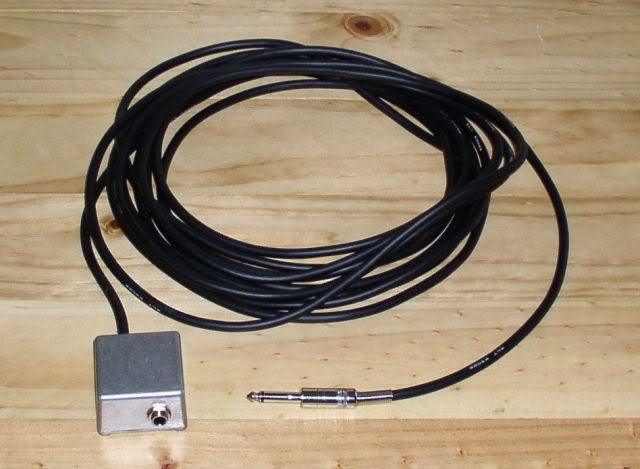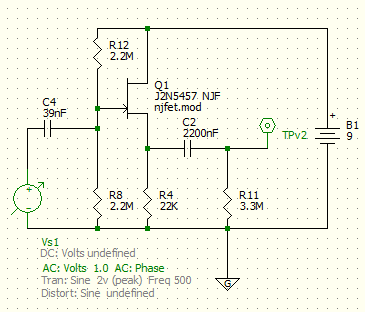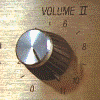Post by JohnH on Sept 30, 2006 23:33:58 GMT -5
There has been some interest in installing buffer circuits inside a guitar, to make the output signal clearer, more robust and unaffected by cable lengths and input impedances downstream. The result is better top-end clarity and consistency in the sound.
(EDIT: 6 October 2006 - see end of this post for a similar circuit built into a jack plug, plus a sound sample)
The most well known circuit for this job is by Don Tillman:
www.till.com/articles/GuitarPreamp/index.html
It is a ‘common source’ design, using a J201 Junction Field Effect Transistor (JFET). It is intended to provide a clean gain of about 3db. If you need some gain, then it is a good configuration. (I am of the opinion however, that it needs another bias resistor , gate to positive, to raise the gate voltage. When I built one exactly to the Tillman schematic, with a J201, it was biased too far ‘off’, and distorted on loud strumming – I’m interested in comments on that).
However - if you don’t need gain from the buffer, then I reckon a ‘source follower’ is a better way to go, since you can get better headroom, lower output impedance and lower current draw.
I’ve built a bunch of these, and installed them in guitars, and as the output stages of stomp boxes. Usually I have used a 2N5457 JFET, as shown on the LP Max thread:
guitarnuts2.proboards45.com/index.cgi?board=schem&action=display&thread=1138768962
Schematic
This post is to present a schematic for a buffer, similar to that on the LPmax, but using a J201. It produces a very clean, no gain, low noise output, with low output impedance:

The schematic shows my preferred values, but many of them are not too critical. The input and output caps C1 and C2 are chosen to give a flat response above about 50Hz. Audibly, C1 can be reduced to 10nF, but less than that and bass response becomes marginally affected.
Output load
C2 is sized for driving an output load of 50k, which is much less (ie, more load) than typical amps which are 500k to 1M. It will also push past long lengths of cable. I tested it loaded by a 50k load and 3.3nF cap plus guitar cord, represented a roughly 100’ cable. There was no audible loss. With three times that capacitor as part of the load (300’ cable equivalent), there was a very slight reduction in treble.
If however, the buffer was intended to be capable of directly driving a line input, then I'd use a much lower source resistor R1 and higher value output cap C2, at the expense of more current draw.
Power supply
For this schematic, I have added R2 in the power supply. The intention is that the power is engaged when a mono jack plug is inserted into a stereo socket, hence connecting the negative. R2, together with C3 helps to smooth out the thump of power on switching on. With a 9V supply, it takes about 0.06 mA once it has settled, not much at all really. I believe it would also be fine with a 6V battery.
With a 9v battery, I'm expecting battery life of at least 5000 hours.
Testing
My testing of this circuit was with the largest guitar signal I could create, with four coils of two humbuckers all in series, thrashing as hard as possible. With the output loaded by 50k, and 100’ cable equivalent, there was no audible distortion, even as supply voltage was reduced. Only when the battery went below about 3.5V was break-up evident.
So I reckon this is tough little cookie, and a robust design.
cheers
John
EDIT: 6 October 2006
Buffer Cable[/u]
A similar circuit can be built into a cable, with the JFET inside the jack plug. This gives most of the benefits of a buffer inside the guitar, but without needing to have a battery built in, or do any work on the guitar itself. Again, the precedent is by Tillman:
www.till.com/articles/PreampCable/
The basic idea is that, with the JFET in the plug, everything downstream of it is low impedance. The circuit is 'stretched', between the jack plug and a box at the other end of the cable, with the battery. The capacitance of the cable that links the two ends is not significant, since it is all in the low-impedance part of he circuit.
I tried one using a source follower design. It works in the same way as the first buffer circuit posted above:

The parts inside the jack plug are just the JFET and a 2.2M gate pull-down resistor. To get this biased properly, with just this one resistor biasing the gate to zero, it needs a different JFET, with a higher gate/source cut off voltage. I used an MPF102, which provides a bias voltage of about 2.5V in this configation, subject to the variability of all JFETS. This gives it enough headroom to deal with large input swings.
Here's some photos of assembling the jack:

Once the resistor is soldered from tip to ground, the JFET is soldered in place. The plastic sleeve is then slipped back and filled with resin and taped, to make the assembly tougher.
At the far end of the cable is a small box, containing the battery, supply components, output jack and source resistor. Since the source is biased to a lower voltage than the J201 version, the source resistor is decreased to give it more pull-down power.
Between the battery and box is a twin-core shielded cable. It is very similar in size and cost to a single core cable. It could be any convenient length, I used 20'. Another 'normal' cable goes from the battery box to the amp, either as a short patch lead, or a normal length cord. Plugging into the battery box engages the power.
Here is a picture of the completed buffer cable:

This buffer cable functions pretty much as well as the built-in buffer version, and is an alternative to it.
Theres also the possibility, as an extension to this idea, to use the same jack-plug and cable arrangement, but have it enter a box with switches to configure it either as a no-gain circuit, or as a common-source design with adjustable gain/treble boost etc.
Sound
I think it is important to realise that the extra clarity that these buffers provide, does have a significant affect on the sound.
Here is a clip, featuring the neck pickup on my Strat, which is a GFS vintage alnico. Excuse my playing. The recording is done crudely, directly into the sound card, without an amp, but with a high impedance preamp (ie the input impedance is not loading the signal).
The first part is without a buffer, through a 20' curly cable. The second is with identical levels and all settings, but through a 20' buffer cable (a built-in buffer sounds the same) , followed by the curly cable. You'll hear a distinct difference between buffered and unbuffered. Both of course, sound better through an amp.
people.smartchat.net.au/~l_jhewitt/circuits/buffcablen.mp3
The difference is due to the cable capacitance. Its accentuated with single-coils rather than humbuckers, by the direct recording rather than through an amp, and by the use of longer rather than shorter cable in the unbuffered version. But I think you can appreciate the general result!
Page 2 of the LPmax thread has further samples, through the internal buffer:
guitarnuts2.proboards45.com/index.cgi?board=schem&action=display&thread=1138768962&page=2
OK, thats all I've got on buffers - for now!
cheers
John
Until now
EDIT 2/05/07
Buffers with gain[/u]
Sometimes we'd like a bit more output than x1
For a simple buffer with gain, I really like this Fetzer valve circuit:
www.runoffgroove.com/fetzervalve.html
The designers have worked out all the parameters to make it match the response of a tube input stage, based on measuring the individual JFET characteristics. I tried one with a J201, and have it built into one of my guitars. It runs at about 120 uA so still very low current, but more than the source follower designs.
It can make a significant boost to push the amp. I haven't got it to overdrive itself however, it stays clean, even with my three-in-series combo. I put it with a 100k volume control after the gain stage. The sound is very clear and its a good alternative to the other buffers where a gain push is wanted.
I think where gain is not wanted however, the previous designs are slightly better, since they have lower current, more headroom, lower output impedance and more tolerance of battery levels.
John
EDIT 20/09/08
I've been tracking down some thumps in my signal chain, due to switching of true bypass stomp boxes downstream. To get rid of these, the buffer and buffer cables need a pull down resistor from output to ground of about 1M, to keep the output cap biased to ground voltage.
EDIT 14/11/09
Here are a couple of versions of JFET stages, as a buffer and then as a gain stage, with more info on how they operate.
Buffer Circuit
The buffer is similar to the previous versions. The key decision is to decide what type of input it needs to drive. The versions above are good for driving into a guitar amp through long cables, and are very economical on power. On this version, I've lowered R4 to give it the ability to drive a guitar or stomp-box signal into a line input of 10-20k input impedance.

Note that all these source follower buffers have a low output impedance determined by the JFET, but if they are overloaded by going to into a low impedance input with a high signal level they can start to distort as R4 tries to pull the voltage down on the downward swings. This is never a problem going into a guitar amp however.
So, this circuit will drive any input, and takes about 0.3mA (not much really - good for about 1000 hour son a 9V battery). If its only for a guitar amp or other high impedance input, R4 can be increased and C2 decreased by a factor of 3 or 4 and its still fine, then current draw is reduced also.
Buffer frequency respone v load
Here's some output from 5Spice:
Circuit:

Graphs are shown for the circuit feeding into three values of output load (R5), and with a range of output caps (C1)
Output frequency response into a 10k load (such as an unbalanced line-in,), with output cap varied from 200nF up to 1200nF = 1.2uF:

100k load:

500k load (such as a guitar amp or stompbox):

The vertical cursor lines are set to 40hz, for bass. With the low impedance load (1st graph), you can see how one might want the largest cap. At higher impedance loads, the cap can be much less if you wish, but I dont see any advantage in going smaller than 390 or 330nF.
Another interesting thing to see from these graphs is that the overall output at higher frequencies is about -0.37db with the high impedance load. This small loss is due to the JFET and is pretty much negligible. At 10k load, the output is about -1.2db, still not a big deal, but it shows how putting a 10k load on this circuit drops the output by about 0.8db. From that, we can estimate the output impedance of the circuit:
10^ (-0.8/20) = 0.91
This is the ratio by which the output voltage drops due to a 10k load, and suggests that the effective output impedance of this circuit is about 1k = not bad at all.
BTW - my calcs are with a 2N5457 JFET, since I dont have a 201 in the model library. But this circuit is not very sensitive to JFET type.
Gain stage
For a stage with gain, a configuration like this can be used:

On this one, if C6 is omitted, the gain is dependent mainly on the ratio of R13 to R4, and about 8 or 9db is available. The voltage at the upper JFET connection (= drain) should be set to about 5.5-6V, by adjusting R13. The JFETs vary quite a lot even within the same batch, so R13 could be +/- a value or two. It could be configured with a trim pot instead.
The output resistance is approximately that of R13, so if it is to drive an output, it needs to be kept fairly low. Even with R13 as 10k, it is still much higher than the 2k output impedance achieved by the circuit above, so this one will drive a guitar amp but not a line input. If however, the stage is within a circuit and does not need to drive an output, R4 and R13 can be increased, approximately in proportion, to reduce current draw. As shown the circuit will take about 0.3mA.
There's another aspect too that I have found with these circuits. As they get driven hard, they crunch quite nicely, but the smoothness of the crunch depends on the current through the JFET. You can get the gain happening with much higher values for R4 and R13, but when it clips it is harder. With R13 at 10-22k, the clipping is softer. Two or three of these stages make a good overdrive pedal.
Finally, cap C6 can increase gain, and with a high value of 10uF, gain can be increased up to about 22db. Smaller caps will only affect higher frequencies. So with the circuit as drawn, 10uF gives overall higer gain, 2.2uF will give a bit less gain to the bass, 220nF will give an upper mid and treble boost while 22nF will just add a bit of extra high treble presence
John
(EDIT: 6 October 2006 - see end of this post for a similar circuit built into a jack plug, plus a sound sample)
The most well known circuit for this job is by Don Tillman:
www.till.com/articles/GuitarPreamp/index.html
It is a ‘common source’ design, using a J201 Junction Field Effect Transistor (JFET). It is intended to provide a clean gain of about 3db. If you need some gain, then it is a good configuration. (I am of the opinion however, that it needs another bias resistor , gate to positive, to raise the gate voltage. When I built one exactly to the Tillman schematic, with a J201, it was biased too far ‘off’, and distorted on loud strumming – I’m interested in comments on that).
However - if you don’t need gain from the buffer, then I reckon a ‘source follower’ is a better way to go, since you can get better headroom, lower output impedance and lower current draw.
I’ve built a bunch of these, and installed them in guitars, and as the output stages of stomp boxes. Usually I have used a 2N5457 JFET, as shown on the LP Max thread:
guitarnuts2.proboards45.com/index.cgi?board=schem&action=display&thread=1138768962
Schematic
This post is to present a schematic for a buffer, similar to that on the LPmax, but using a J201. It produces a very clean, no gain, low noise output, with low output impedance:

The schematic shows my preferred values, but many of them are not too critical. The input and output caps C1 and C2 are chosen to give a flat response above about 50Hz. Audibly, C1 can be reduced to 10nF, but less than that and bass response becomes marginally affected.
Output load
C2 is sized for driving an output load of 50k, which is much less (ie, more load) than typical amps which are 500k to 1M. It will also push past long lengths of cable. I tested it loaded by a 50k load and 3.3nF cap plus guitar cord, represented a roughly 100’ cable. There was no audible loss. With three times that capacitor as part of the load (300’ cable equivalent), there was a very slight reduction in treble.
If however, the buffer was intended to be capable of directly driving a line input, then I'd use a much lower source resistor R1 and higher value output cap C2, at the expense of more current draw.
Power supply
For this schematic, I have added R2 in the power supply. The intention is that the power is engaged when a mono jack plug is inserted into a stereo socket, hence connecting the negative. R2, together with C3 helps to smooth out the thump of power on switching on. With a 9V supply, it takes about 0.06 mA once it has settled, not much at all really. I believe it would also be fine with a 6V battery.
With a 9v battery, I'm expecting battery life of at least 5000 hours.
Testing
My testing of this circuit was with the largest guitar signal I could create, with four coils of two humbuckers all in series, thrashing as hard as possible. With the output loaded by 50k, and 100’ cable equivalent, there was no audible distortion, even as supply voltage was reduced. Only when the battery went below about 3.5V was break-up evident.
So I reckon this is tough little cookie, and a robust design.
cheers
John
EDIT: 6 October 2006
Buffer Cable[/u]
A similar circuit can be built into a cable, with the JFET inside the jack plug. This gives most of the benefits of a buffer inside the guitar, but without needing to have a battery built in, or do any work on the guitar itself. Again, the precedent is by Tillman:
www.till.com/articles/PreampCable/
The basic idea is that, with the JFET in the plug, everything downstream of it is low impedance. The circuit is 'stretched', between the jack plug and a box at the other end of the cable, with the battery. The capacitance of the cable that links the two ends is not significant, since it is all in the low-impedance part of he circuit.
I tried one using a source follower design. It works in the same way as the first buffer circuit posted above:

The parts inside the jack plug are just the JFET and a 2.2M gate pull-down resistor. To get this biased properly, with just this one resistor biasing the gate to zero, it needs a different JFET, with a higher gate/source cut off voltage. I used an MPF102, which provides a bias voltage of about 2.5V in this configation, subject to the variability of all JFETS. This gives it enough headroom to deal with large input swings.
Here's some photos of assembling the jack:

Once the resistor is soldered from tip to ground, the JFET is soldered in place. The plastic sleeve is then slipped back and filled with resin and taped, to make the assembly tougher.
At the far end of the cable is a small box, containing the battery, supply components, output jack and source resistor. Since the source is biased to a lower voltage than the J201 version, the source resistor is decreased to give it more pull-down power.
Between the battery and box is a twin-core shielded cable. It is very similar in size and cost to a single core cable. It could be any convenient length, I used 20'. Another 'normal' cable goes from the battery box to the amp, either as a short patch lead, or a normal length cord. Plugging into the battery box engages the power.
Here is a picture of the completed buffer cable:

This buffer cable functions pretty much as well as the built-in buffer version, and is an alternative to it.
Theres also the possibility, as an extension to this idea, to use the same jack-plug and cable arrangement, but have it enter a box with switches to configure it either as a no-gain circuit, or as a common-source design with adjustable gain/treble boost etc.
Sound
I think it is important to realise that the extra clarity that these buffers provide, does have a significant affect on the sound.
Here is a clip, featuring the neck pickup on my Strat, which is a GFS vintage alnico. Excuse my playing. The recording is done crudely, directly into the sound card, without an amp, but with a high impedance preamp (ie the input impedance is not loading the signal).
The first part is without a buffer, through a 20' curly cable. The second is with identical levels and all settings, but through a 20' buffer cable (a built-in buffer sounds the same) , followed by the curly cable. You'll hear a distinct difference between buffered and unbuffered. Both of course, sound better through an amp.
people.smartchat.net.au/~l_jhewitt/circuits/buffcablen.mp3
The difference is due to the cable capacitance. Its accentuated with single-coils rather than humbuckers, by the direct recording rather than through an amp, and by the use of longer rather than shorter cable in the unbuffered version. But I think you can appreciate the general result!
Page 2 of the LPmax thread has further samples, through the internal buffer:
guitarnuts2.proboards45.com/index.cgi?board=schem&action=display&thread=1138768962&page=2
OK, thats all I've got on buffers - for now!
cheers
John
Until now
EDIT 2/05/07
Buffers with gain[/u]
Sometimes we'd like a bit more output than x1
For a simple buffer with gain, I really like this Fetzer valve circuit:
www.runoffgroove.com/fetzervalve.html
The designers have worked out all the parameters to make it match the response of a tube input stage, based on measuring the individual JFET characteristics. I tried one with a J201, and have it built into one of my guitars. It runs at about 120 uA so still very low current, but more than the source follower designs.
It can make a significant boost to push the amp. I haven't got it to overdrive itself however, it stays clean, even with my three-in-series combo. I put it with a 100k volume control after the gain stage. The sound is very clear and its a good alternative to the other buffers where a gain push is wanted.
I think where gain is not wanted however, the previous designs are slightly better, since they have lower current, more headroom, lower output impedance and more tolerance of battery levels.
John
EDIT 20/09/08
I've been tracking down some thumps in my signal chain, due to switching of true bypass stomp boxes downstream. To get rid of these, the buffer and buffer cables need a pull down resistor from output to ground of about 1M, to keep the output cap biased to ground voltage.
EDIT 14/11/09
Here are a couple of versions of JFET stages, as a buffer and then as a gain stage, with more info on how they operate.
Buffer Circuit
The buffer is similar to the previous versions. The key decision is to decide what type of input it needs to drive. The versions above are good for driving into a guitar amp through long cables, and are very economical on power. On this version, I've lowered R4 to give it the ability to drive a guitar or stomp-box signal into a line input of 10-20k input impedance.

Note that all these source follower buffers have a low output impedance determined by the JFET, but if they are overloaded by going to into a low impedance input with a high signal level they can start to distort as R4 tries to pull the voltage down on the downward swings. This is never a problem going into a guitar amp however.
So, this circuit will drive any input, and takes about 0.3mA (not much really - good for about 1000 hour son a 9V battery). If its only for a guitar amp or other high impedance input, R4 can be increased and C2 decreased by a factor of 3 or 4 and its still fine, then current draw is reduced also.
Buffer frequency respone v load
Here's some output from 5Spice:
Circuit:

Graphs are shown for the circuit feeding into three values of output load (R5), and with a range of output caps (C1)
Output frequency response into a 10k load (such as an unbalanced line-in,), with output cap varied from 200nF up to 1200nF = 1.2uF:

100k load:

500k load (such as a guitar amp or stompbox):

The vertical cursor lines are set to 40hz, for bass. With the low impedance load (1st graph), you can see how one might want the largest cap. At higher impedance loads, the cap can be much less if you wish, but I dont see any advantage in going smaller than 390 or 330nF.
Another interesting thing to see from these graphs is that the overall output at higher frequencies is about -0.37db with the high impedance load. This small loss is due to the JFET and is pretty much negligible. At 10k load, the output is about -1.2db, still not a big deal, but it shows how putting a 10k load on this circuit drops the output by about 0.8db. From that, we can estimate the output impedance of the circuit:
10^ (-0.8/20) = 0.91
This is the ratio by which the output voltage drops due to a 10k load, and suggests that the effective output impedance of this circuit is about 1k = not bad at all.
BTW - my calcs are with a 2N5457 JFET, since I dont have a 201 in the model library. But this circuit is not very sensitive to JFET type.
Gain stage
For a stage with gain, a configuration like this can be used:

On this one, if C6 is omitted, the gain is dependent mainly on the ratio of R13 to R4, and about 8 or 9db is available. The voltage at the upper JFET connection (= drain) should be set to about 5.5-6V, by adjusting R13. The JFETs vary quite a lot even within the same batch, so R13 could be +/- a value or two. It could be configured with a trim pot instead.
The output resistance is approximately that of R13, so if it is to drive an output, it needs to be kept fairly low. Even with R13 as 10k, it is still much higher than the 2k output impedance achieved by the circuit above, so this one will drive a guitar amp but not a line input. If however, the stage is within a circuit and does not need to drive an output, R4 and R13 can be increased, approximately in proportion, to reduce current draw. As shown the circuit will take about 0.3mA.
There's another aspect too that I have found with these circuits. As they get driven hard, they crunch quite nicely, but the smoothness of the crunch depends on the current through the JFET. You can get the gain happening with much higher values for R4 and R13, but when it clips it is harder. With R13 at 10-22k, the clipping is softer. Two or three of these stages make a good overdrive pedal.
Finally, cap C6 can increase gain, and with a high value of 10uF, gain can be increased up to about 22db. Smaller caps will only affect higher frequencies. So with the circuit as drawn, 10uF gives overall higer gain, 2.2uF will give a bit less gain to the bass, 220nF will give an upper mid and treble boost while 22nF will just add a bit of extra high treble presence
John












